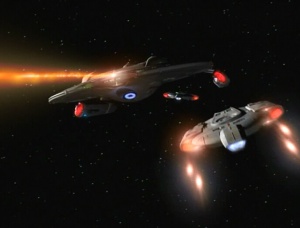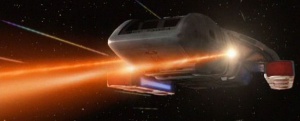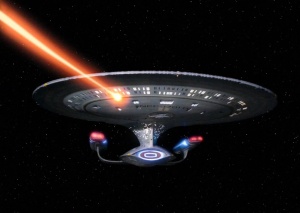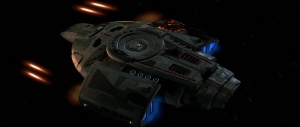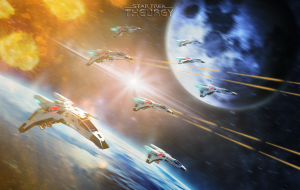Phaser Technology: Difference between revisions
From Star Trek: Theurgy Wiki
m (→Type-III EVA Variant: Spelling correction) |
Auctor Lucan (talk | contribs) |
||
| (64 intermediate revisions by 4 users not shown) | |||
| Line 1: | Line 1: | ||
[[File:Wenn.png| | {| class="wikitable floatright" style="width: 20%; background: #252525; color: white;" | ||
| [[File:Wenn.png|300px]] | |||
|- | |||
| [[File:Cricket.png|300px]] | |||
|- | |||
| Type-I Phaser | |||
|- | |||
| | |||
|- | |||
| [[File:Type-II.png|300px]] | |||
|- | |||
| Type-II Phaser | |||
|- | |||
| | |||
|- | |||
| [[File:TYPE-II-PULSE-PHASE-PISTOL.png|300px]] | |||
|- | |||
| Type-II Pulse Phase Pistol | |||
|- | |||
| | |||
|- | |||
| [[File:Type-III.png|300px]] | |||
|- | |||
| Type-III Phaser Assault Rifle | |||
|- | |||
| | |||
|- | |||
| [[File:Type-III-RVA.png|300px]] | |||
|- | |||
| Type-III EVA-issue Phaser Assault Rifle | |||
|} | |||
'''Phasers''' (an acronym for '''PHAS'''ed '''E'''nergy '''R'''ectification) were the most common and standard directed energy weapon in the arsenal of [[Starfleet]] and several other powers. Most phasers were classified as particle weapons and fire nadion particle beams. Based on the intensity and field of the beam and a variety of adjustments, a wide variety of effects could be achieved. All [[Starfleet]] phasers followed a similar naming convention, with the lowest being handheld and each higher number becoming more powerful and larger in size. After the Type-III, Phasers were too unwieldy to be hand operated and required such power that they were only suitable to be attached to vehicles, vessels, or outposts. | |||
==Handheld Phasers== | ==Handheld Phasers== | ||
Utilized primarily in defensive situations, Handheld phasers had several applications, from use as a weapon to use as a cutting tool, explosive device, or energy source. Storing considerable energy, most phasers were distinguished by their size and firing | Utilized primarily in defensive situations, Handheld phasers had several applications, from use as a weapon to use as a cutting tool, explosive device, or energy source. Storing considerable energy, most phasers were distinguished by their size and firing capabilities, with all models able to output a focused energy discharge in the form of a beam or steady stream. | ||
===Type-I=== | ===Type-I=== | ||
Colloquially know as the "Cricket", the type-I phaser was the smallest, most basic weapon carried by [[Starfleet]] and other [[United Federation of Planets|Federation]] personnel. Easily concealable, the type-I was able to be programmed to fire automatically at set intervals. However, due to the lack of its operating capabilities, longevity and diversity when compared to its larger brethren, the type-I phasers were typically only carried when it would be inappropriate to carry a larger weapon, such as on diplomatic missions. Because of this, the type-I was synonymous with secret missions and seldom seen in active use. | Colloquially know as the "Cricket", the type-I phaser was the smallest, most basic weapon carried by [[Starfleet]] and other [[United Federation of Planets|Federation]] personnel. Easily concealable, the type-I was able to be programmed to fire automatically at set intervals. However, due to the lack of its operating capabilities, longevity, and diversity when compared to its larger brethren, the type-I phasers were typically only carried when it would be inappropriate to carry a larger weapon, such as on diplomatic missions. Because of this, the type-I was synonymous with secret missions and seldom seen in active use. | ||
===Type-II=== | ===Type-II=== | ||
The type-II was the standard weapon used aboard all [[Starfleet]] vessels and bases, as it offered a very favorable compromise between size and power. Originally designed to encompass the type-I, the type-II held a pistol-like grip. By the 2360s, the type-II had evolved past that configuration, becoming a sleek, silver-colored device with a handle flowing into the form of a muzzle cowling and emitter. The type-II phaser | The type-II was the standard weapon used aboard all [[Starfleet]] vessels and bases, as it offered a very favorable compromise between size and power. Originally designed to encompass the type-I, the type-II held a pistol-like grip. By the 2360s, the type-II had evolved past that configuration, becoming a sleek, silver-colored device with a handle flowing into the form of a muzzle cowling and emitter. The type-II phaser was a required piece of equipment for most [[Starfleet]] away teams, and was the basic sidearm of [[Security|Starfleet security]] teams | ||
With two small buttons for beam width and intensity control and a large one to fire the device, the type-II featured a large, illuminated power level readout. The phaser retained the functionality of the previous designs, but increased the power and versatility. Like their predecessors, these units could be adjusted for use as cutting tools or power sources. They could also be set to overload, becoming a powerful explosive device. | With two small buttons for beam width and intensity control and a large one to fire the device, the type-II featured a large, illuminated power level readout. The phaser retained the functionality of the previous designs, but increased the power and versatility. Like their predecessors, these units could be adjusted for use as cutting tools or power sources. They could also be set to overload, becoming a powerful explosive device. | ||
In addition to more variable power settings than the Type-I, Type-II Phasers | In addition to more variable power settings than the Type-I, Type-II Phasers were able to be set for a "narrow" (affecting a single target) or "wide" beam (affecting two or more targets over a certain area). The frequency of the beam could also be adjusted to make it more effective against certain types of shields and/or force fields. | ||
====Type-II Pulse Phase Pistol==== | ====Type-II Pulse Phase Pistol==== | ||
During the Dominion | <include iframe src="https://sketchfab.com/models/af9cf06b6a69491b93fb46292d9d5275/embed" width="490" height="380" frameborder="0" scrolling="no" allowfullscreen="allowfullscreen" mozallowfullscreen="true" webkitallowfullscreen="true" onmousewheel="" /> | ||
During the [[Dominion War]], it became apparent that single beam particle weapons were ineffective against groups of Jem’Hadar. As such, [[Security|Starfleet Security]] desired the ability to fire multiple short pulses of energy. The Type-III rifle was easily modified with a change of beam emitter, but due to the smaller size, the Type-II was unable to be modified in such a way. | |||
Because of the difference in shape and fire pattern, [[Starfleet]] Personnel required further training on this weapon in addition to standard phaser profiency. As such, the type-II Pulse Phase Pistol was standardly reserved for [[Security]] and [[Tactical Conn]] personnel. | With the need of a small weapon for use in close quarter situations, this handphaser variant Type-II Pulse Phase Pistol was created. Not only to be easily distinguishable between the conventional Type-II and this pulse fire variant, but to also account for an increased need for stability and accuracy, this new weapon took design elements of more traditional handheld weapons, incorporating a pistol-like grip and hard sight points along the top of the device. | ||
Because of the difference in shape and fire pattern, [[Starfleet]] Personnel required further training on this weapon in addition to standard phaser profiency. As such, the type-II Pulse Phase Pistol was standardly reserved for [[Security]] and [[Tactical Conn]] personnel. | |||
===Type-III=== | ===Type-III=== | ||
The largest standard phaser issued to Starfleet personnel, the Type-III (or simply referred to as the phaser rifle) was a two handed weapon capable of greater accuracy and longevity | [[File:Lock_and_Load.gif|300px|left|thumb|''Click for animation. 1) Checking power level 2) Safety off. Gif from Star Trek: Nemesis.'']]The largest standard phaser issued to [[Starfleet]] personnel, the Type-III (or simply referred to as the phaser rifle) was a two handed weapon capable of greater accuracy and longevity than its type-II counterpart. Even though the type-III had a much greater energy reserve, this only translated to an increase of longer periods of fire rather than any rise in output levels over one-handed phasers. Phaser rifles were not standard landing party equipment aboard [[Starfleet]] vessels. Typically, rifles were equipped only when firepower heavier than that of the type-II phaser was required. | ||
Originally a bulky device with the capability of its rear handle to be rotated into a shoulder stock, the type-III was more streamlined and smaller by the 2360s. In the early 2370s, the need for accuracy caused the design aesthetic of the weapon to change once again, this time the rifle returned to having a shoulder stock but also incorporated a rear pistol-like and front under barrel grip, a combined sight and tactical light, and an integrated shoulder sling for ease of carrying. | Originally a bulky device with the capability of its rear handle to be rotated into a shoulder stock, the type-III was more streamlined and smaller by the 2360s. In the early 2370s, the need for accuracy caused the design aesthetic of the weapon to change once again, this time the rifle returned to having a shoulder stock but also incorporated a rear pistol-like and front under barrel grip, a combined sight and tactical light, and an integrated shoulder sling for ease of carrying. | ||
The outbreak of the dominion war caused a need for weapons to fire in multiple bursts rather than just a single beam of energy. [[Security|Starfleet Security]] created two new weapons for this purpose - the Type II Pulse Phase Pistol and the Type-III Phaser Compression Rifle. By 2375, the Compression Rifle was removed from service, due to comparable capabilities produced from the standard type-III with a change to its beam emitter. The switch between the angular and smooth beam emitters on the type-III rifles allowed the weapons to fire both single beam and pulses of energy at will by the operator. | The outbreak of the [[dominion]] war caused a need for weapons to fire in multiple bursts rather than just a single beam of energy. [[Security|Starfleet Security]] created two new weapons for this purpose - the Type II Pulse Phase Pistol and the Type-III Phaser Compression Rifle. By 2375, the Compression Rifle was removed from service, due to comparable capabilities produced from the standard type-III with a change to its beam emitter. The switch between the angular and smooth beam emitters on the type-III rifles allowed the weapons to fire both single beam and pulses of energy at will by the operator. | ||
After the completion of the [[dominion]] war, in the late 2370s, [[Security|Starfleet Security]] updated the sights of the type-III to a red holographic style allowing for great accuracy and target acquisition. The integrated flashlight was unaffected. | |||
====Type-III EVA Variant==== | ====Type-III EVA Variant==== | ||
During the 2370s, [[Starfleet]] produced an additional variant of the type-III specifically designed for EVA missions. This rifle had unique features including, two pistol-like grips for ease of handling, no trigger guard to allow for use by personnel wearing [[ | During the 2370s, [[Starfleet]] produced an additional variant of the type-III specifically designed for EVA missions. This rifle had unique features including, two pistol-like grips for ease of handling, no trigger guard to allow for use by personnel wearing [[EVA Suit]]s, and magnetic areas allowing the rifle to be attached to a ship's hull. | ||
This variant was later removed from service by [[Starfleet]]; however, due to its popularity among officers, there were still many units available in the field. Before the acquisition of the [[the_Accipiter|Accipiter]] rifles [[Ryuan Sel]], the Mistress-of-Arms of the ''[[USS Theurgy]]'' was known to prefer this weapon. | |||
==Phaser Rifle Evolution== | |||
[[File:Phaser-Rifle-Evolution.png|500px]] | |||
==Settings== | |||
All handheld | All handheld Phasers used a common scale to denote the power output of the weapon, however, not all phasers could achieve the highest settings. Type-I Phasers were only able to reach settings 1-8, whereas type-II and type-III are able to make use of all sixteen. | ||
{| class="wikitable " style=" background: #252525; color: white; white-space: nowrap; " | {| class="wikitable " style=" background: #252525; color: white; white-space: nowrap; " | ||
| Line 48: | Line 84: | ||
| Light Stun | | Light Stun | ||
| | | | ||
* Base-type humanoids | * Base-type humanoids suffered temporary impairment resulting in slight daze and inability to stand | ||
* Prolonged exposure | * Prolonged exposure was capable of inducing sufficient trauma to kill if fired at a vital organ and at close range | ||
|- | |- | ||
| <b> 2 </b> | | <b> 2 </b> | ||
| Medium Stun | | Medium Stun | ||
| | | | ||
* Base-type humanoids | * Base-type humanoids remained unconscious for up to 15 minutes | ||
|- | |- | ||
| <b> 3 </b> | | <b> 3 </b> | ||
| Heavy Stun | | Heavy Stun | ||
| | | | ||
* Base-type humanoids | * Base-type humanoids remained unconscious for an average of 1 hour | ||
|- | |- | ||
| <b> 4 </b> | | <b> 4 </b> | ||
| Low Thermal | | Low Thermal | ||
| | | | ||
* Base-type humanoids | * Base-type humanoids experienced epidermal trauma | ||
* Prolonged discharges | * Prolonged discharges produced deep heat storage effects within metal alloys | ||
|- | |- | ||
| <b> 5 </b> | | <b> 5 </b> | ||
| High Thermal | | High Thermal | ||
| | | | ||
* Base-type humanoids | * Base-type humanoids experienced severe burns | ||
* Short discharges | * Short discharges produced deep heat storage effects within metal alloys | ||
|- | |- | ||
| <b> 6 </b> | | <b> 6 </b> | ||
| Low Disruption | | Low Disruption | ||
| | | | ||
* Organic tissues and structural materials both | * Organic tissues and structural materials both exhibited molecular damage | ||
|- | |- | ||
| <b> 7 </b> | | <b> 7 </b> | ||
| Moderate Disruption | | Moderate Disruption | ||
| | | | ||
* Organic tissue | * Organic tissue received substantial damage, and would kill most base-type humanoids | ||
|- | |- | ||
| <b> 8 </b> | | <b> 8 </b> | ||
| Medium Disruption | | Medium Disruption | ||
| | | | ||
* Organic tissue and light alloys | * Organic tissue and light alloys vaporized | ||
|- | |- | ||
| <b> 9 </b> | | <b> 9 </b> | ||
| High Disruption | | High Disruption | ||
| | | | ||
* Medium alloys | * Medium alloys vaporized | ||
|- | |- | ||
| <b> 10 </b> | | <b> 10 </b> | ||
| Extreme Disruption | | Extreme Disruption | ||
| | | | ||
* Heavy alloys | * Heavy alloys vaporized | ||
|- | |- | ||
| <b> 11 </b> | | <b> 11 </b> | ||
| Slight Explosive | | Slight Explosive | ||
| | | | ||
* Ultradense alloys | * Ultradense alloys vaporized | ||
* Approximately 10m<sup>3</sup> of rock | * Approximately 10m<sup>3</sup> of rock was explosively detached by a single discharge | ||
|- | |- | ||
| <b> 12 </b> | | <b> 12 </b> | ||
| Low Explosive | | Low Explosive | ||
| | | | ||
* Approximately 50m<sup>3</sup> of rock | * Approximately 50m<sup>3</sup> of rock was explosively detached by a single discharge | ||
|- | |- | ||
| <b> 13 </b> | | <b> 13 </b> | ||
| Moderate Explosive | | Moderate Explosive | ||
| | | | ||
* Shielded matter | * Shielded matter exhibited minor heating effects | ||
* Approximately 90m<sup>3</sup> of rock | * Approximately 90m<sup>3</sup> of rock was explosively detached by a single discharge | ||
|- | |- | ||
| <b> 14 </b> | | <b> 14 </b> | ||
| Medium Explosive | | Medium Explosive | ||
| | | | ||
* Shielded matter | * Shielded matter exhibited medium heating effects | ||
* Approximately 160m<sup>3</sup> of rock | * Approximately 160m<sup>3</sup> of rock was explosively detached by a single discharge | ||
|- | |- | ||
| <b> 15 </b> | | <b> 15 </b> | ||
| High Explosive | | High Explosive | ||
| | | | ||
* Shielded matter | * Shielded matter exhibited major heating effects | ||
* Approximately 370m<sup>3</sup> of rock | * Approximately 370m<sup>3</sup> of rock was explosively detached by a single discharge | ||
|- | |- | ||
| <b> 16 </b> | | <b> 16 </b> | ||
| Extreme Explosive | | Extreme Explosive | ||
| | | | ||
* Shielded matter | * Shielded matter exhibited minor fracturing | ||
* Approximately 650m<sup>3</sup> of rock | * Approximately 650m<sup>3</sup> of rock was explosively detached by a single discharge | ||
|- | |- | ||
|} | |} | ||
==Vessel-mounted | ==Vessel-mounted Energy Weaponry== | ||
Originally, starships used phaser banks. Each bank contained one or more phaser emitters from which the beam energy was released. These systems shared common power sources and targeting systems. In the 2270s, phaser power systems of [[United Federation of Planets|Federation]] starships were redesigned to channel power directly from the warp core, thereby increasing the power output of phaser banks. | |||
Directed energy weapons projected bolts or beams of focused energy or energized particles at a target. These weapons were commonplace, with most cultures having some form or another of directed energy weapon as the typical armament of their spacecraft, and they drew upon the abundant energy that starships generated. Energy weapons were composed of a type and a delivery method. [[Federation]] starships rarely used any other kind of directed energy weaponry than phasers. The delivery method of a phaser described how the emitters were arranged, and how the weapon was set-up to fire. | |||
'''Cannons''' were close range, rapid-firing weapons that projected pulses or bolts of energy rather than consistent beams. These were inaccurate at longer ranges, but the volley of quick pulses could be devastating. '''Banks''' were a collection of emitters used early on by [[Starfleet]], designed to fire in unison. They produced a focused beam of energy that could inflict considerable damage. '''Arrays''' were a more advanced technology, with long strips of linked emitters that shared a power feed, allowing the ship to fire from any point along the strip. This allowed the ship to fire in multiple directions at once, or to adjust and fire on moving targets repeatedly in quick succession. | |||
[[File:Akira_and_Defiants_fire,_2374.jpg|300px|thumb|Image: Akira-class starship firing from a phaser array and a Defiant-class starship firing with phaser cannons<br><small>Image © Paramount</small>]]Originally, starships used phaser banks. Each bank contained one or more phaser emitters from which the beam energy was released. These systems shared common power sources and targeting systems. In the 2270s, phaser power systems of [[United Federation of Planets|Federation]] starships were redesigned to channel power directly from the [[warp]] core, thereby increasing the power output of phaser banks. | |||
By the | By the 24<sup>th</sup> century, the number of emitters in each bank had been increased to the point where they were laid out in long strips called phaser arrays. The arrays aboard a Galaxy-class starship could channel vast energy in a short time frame, capable of cutting through a mile of solid granite in seconds. Starship-mounted phasers were normally set to fire steady streams of phaser energies that would travel along the emitter strip and converge at the best position for targeting. Following the Battle of Wolf-359, [[Starfleet]] Engineers were also able to reconfigure the emitters in a different layout that allowed the phaser bank to rapid-fire as phaser cannons. | ||
In addition to the powerful settings, the ship's phasers also had a stun setting that could be used to render lifeforms unconscious when fired at a planetary surface from orbit. It was also possible to configure starship phasers to also fire energy beams for power transfer. | In addition to the powerful settings, the ship's phasers also had a stun setting that could be used to render lifeforms unconscious when fired at a planetary surface from orbit. It was also possible to configure starship phasers to also fire energy beams for power transfer. | ||
There were many different type-of phasers mounted to starships. As new [[Phaser Technology|phaser technology]] became available, it was placed onto the ships being built at the time. Below are a few examples of phaser types mounted to various ship at the time of their initial construction. | |||
There were many different type of phasers mounted to starships | |||
====Type-IV Phaser Bank==== | |||
The smallest phaser bank currently deployed in the [[Federation]], the Type-IV was markedly superior to the Type-III phaser rifle, providing more power, range, accuracy and adaptability. As such, it had been the workhorse of [[Starfleet]]'s auxiliary craft fleet for decades, as well as being mounted on a number of ground based vehicles. Only by 2381 is it being replaced by the Type-V array, a weapon of comparable simplicity but greater ability. It was not a very strong offensive measure but was capable of warding a small craft from many natural threats, such as asteroids and debris, and similar sized craft. Type-6 Shuttlecraft were known to operate with Type-IV Phasers. | |||
==== Type-V Phaser Bank ==== | |||
A phaser bank generally found on small but high-powered [[Starfleet]] shuttlecraft, the Type-V was generally considered to be the next feasible replacement for the Type-IV array found on several thousand shuttles throughout the [[Federation]]. While not as powerful as the Type-VI or Type-VII, what it lacked in strength and longevity was more than made up for in its simplicity. Indeed, it rivalled even the modern Type-IV variant commonly found on shuttlecraft for ease of construction, maintenance and repair. | |||
==== Type-VI Phaser Bank ==== | |||
[[File:e917d751c2189404fc6a588762cf95f9.jpg|right|thumb|300px|<small>Image © Paramount</small>]] | |||
The second largest bank used on small craft such as runabouts, the Type-VI phaser bank was undeniably more powerful than its more dimunitive counterparts, with faster recharge rates, ranges and, of course, offensive capabilities, but lacked several of the advantageous maintenance and power factors found in its Type-VII fellow. Most remarkably, the Type-VI's increase in power over its smaller counterparts was less than the equivalent difference between it and the Type-VII, a characteristic explained by the (then) advanced techniques used in its construction and new methods of energy dissipation. | |||
The Type-VI was not as commonly found as any of its counterparts, primarily due to the detailed work required in constructing it and the real but admittedly barely significant advantage in [[tactical]] situations it provided over the Type-V. It had, however, been found to be a suitable armament for some shuttlecraft, its intricate composition easily adaptable to some shuttles' requirements. | |||
==== Type-VII Phaser Array ==== | |||
The largest emitter used on small craft such as runabouts and light escorts, the Type-VII phaser array was considerably more powerful than its more dimunitive counterparts, with faster recharge rates, ranges and, of course, offensive capabilities. | |||
Recent advances in technology had allowed [[Starfleet]] to decrease the overall size of the Type-VII, thereby allowing it to be employed on vessels previously considered to be much too small to cope with the necessary machinery. As such, the Type-VII was markedly superior to the Type-VI phaser array but, due to practical issues, fell a bit short of the standard Type-VIII arrays being deployed on starships as of 2381. | |||
==== Type-VIII Phaser Array ==== | |||
The Type-VIII was the phaser armament of choice for most of [[Starfleet]]'s small-to medium-sized ships. While varying degrees of power and capabilities could be found from class to class - even from ship to ship - the general Type-VIII operating principles remained the same and any deviations in any regard were usually negligible. This phaser type-provided excellent offensive and defensive capabilities for many ship classes that, due to their size, required significant quantities of internal volume for other [[operations]] which would otherwise be consumed by larger phaser weaponry. | |||
Originally these weapons were installed in phaser banks aboard ships like the Excelsior-class and Constellation-class. Ships equipped with them as of 2381 were set in the standard array package. The only fighters that held dedicated Type-VIII phaser emitters were the [[AC-477 Mk I Valravn]] fighters, and those emitters were prototype-technology as of 2381, mounted on only twenty constructed fighters. On these fighters, the [[warp]] drive plasma conduit ran through the primary phaser coupling to double the power of the beams. It is as of yet unknown how the emitters would last in a prolonged engagement. | |||
==== Type-IX Phaser Array ==== | |||
[[File:Galaxy_class_firing_phasers_HD.jpg|300px|thumb|Image: Galaxy-class firing a Type-X array<br><small>Image © Paramount</small>]] | |||
This was the armament of choice for many of [[Starfleet]]'s larger vessels and some of its medium-sized but patrol/combat-oriented craft. While bulkier and more complicated than its Type-VIII counterpart, the Type-IX provided excellent firepower with an impressive rate of fire that could only be bettered by Type-X, Type-XII or Type-U weapons. | |||
Recent advances in weapons technology had allowed [[Starfleet]] to reduce the operating size for the Type-IX's components, allowing for this array to be employed as the new phaser weaponry of even refitted 23rd century starships. | |||
==== Type-X Phaser Array ==== | |||
Until the development of the Type-XII, the Type-X was the heaviest weapon in use aboard [[Federation]] vessels, comprising the main armament of the Galaxy class starship. The Type-X had since seen its incorporation into other ship classes, providing significant firepower to some of [[Starfleet]]'s largest vessels. Galaxy and Intrepid-class vessels were originally fitted with Type-X Phasers. | |||
==== Type-XI Phaser Array ==== | |||
Type-XI phaser was used normally for planetary defense. The emitters were designed to minimize atmospheric blooming of the beam. The phaser emitters in the carriages, embedded into the habitat ring of [[Deep Space 9]], were of this type, modified for use in space. | |||
==== Type-XII Phaser Array ==== | |||
Previously designated as the 'Type-X+' for [[security]] reasons, the Type-XII phaser has been used in dedicated planetary defence arrays and as the main armament of heavy fortified starbases since 2363. It was considered that the Type-XII was unsuitable for use on a starship because the power requirements were too high and the support systems too bulky. However, by 2368 technical improvements had allowed for considerable shrinkage in the size of the equipment, and ship power systems had become capable of supporting the weapon. The main phaser armament of the new Sovereign-class starship therefore comprised Type-XII phaser arrays, as did the armament of the ''Prometheus''-class. These are the most powerful phaser beam emitters currently in use by the [[Federation]], the pulse phaser variant not withstanding. | |||
==== Type-XII Pulse Phaser Array ==== | |||
This was the kind of phaser arrays that the ''[[USS Theurgy]]'' had installed, where there were two firing options available. Either beam emission or phaser pulse, depending on the situation. See Type-U below for more info on the pulse phaser kind of setting. | |||
==== Type-U Pulse Phaser Cannon ==== | |||
[[File:USS_Defiant,_First_Contact.jpg|right|300px|thumb|Image: Defiant-class firing four Type-U cannons<br><small>Image © Paramount</small>]] | |||
A relatively new development in [[Phaser Technology|phaser technology]], the Type-U pulse phaser was the most combat-focused development of the phaser to date. It combined large, nearly flawless emitter crystals with rapid-discharge EPS banks and high-speed beam focusing coils. The system allowed the charge to be stored in the coils for a few nanoseconds, then released it as a layered pulse. Due to its nature, shields and armour had a harder time dispersing the pulse, resulting in more damage to the target. Pulse phasers were first deployed on the [[USS Defiant]], where they managed to cause significant damage to [[Jem'Hadar]] fighters in a short space of time. | |||
==== Type-U+ Pulse Phaser Cannon ==== | |||
This weapon worked on the same principles as the Type-U but at a much smaller scale as well as 40 % of the yield. It was an armament commonly found on the [[Federation]]'s fleet of fighters and a number of auxiliary craft. The first iteration of the U+ could be seen on either side of the [[AC-307 Mk II Valkyrie]] fighter, but a second version was made to be wing-mounted on the [[AC-409 Mk III Valkyrie]]. It was the same technology in both versions of the U+ cannons, only on the [[AC-409 Mk III Valkyrie|Mk III]], the entire weapon system was mounted on the wings instead of being inside the fuselage of the fighter (as it is in the [[AC-307 Mk II Valkyrie|Mk II]]). Furthermore, while the technology was the same, as an upgrade from the [[AC-307 Mk II Valkyrie|Mk II]], the [[warp]] drive plasma conduit ran through the primary phaser coupling to increase the power of the [[AC-409 Mk III Valkyrie|Mk III]]’s phaser cannons, giving it 50 % yield compared to the Type-U. | |||
[[File:Dor'GhItlh-Squardon.png|300px|right|thumb|Image: Gryphons firing Type-U+ phaser cannons]] | |||
There were pulse or beam firing options available. Bolts had a firing rate of 5 per second. The beam setting had lower yield but longer range. | |||
==== Type-I Rawley Heavy Pulse Phaser Cannon ==== | |||
Like the [[AC-409 Mk III Valkyrie]]'s wing-mounted pulse phaser cannons, the first and only iteration of the heavy Rawley cannon was also wing-mounted, and it demanded that the [[warp]] drive plasma conduit ran through the primary phaser coupling. Unlike the Type-U+, the Rawley cannon had a tendency to overheat during prolonged engagements, instead made for quick strikes and a mandatory cool-down period between such strikes. The benefit was that its yield was higher than the [[AC-409 Mk III Valkyrie|Mk III]]'s phaser cannons, at the lower firing rate of 3 bolts per second. Their yield was approximately 60 % of the Type-U pulse phaser cannons. | |||
The Rawley cannons did not have a beam firing option available, and they were mounted as standard armament on the [[AC-347 Knight-class Interceptor]]. After the refit of the [[SS Sabine NX-59846]], it also had two of these cannons mounted underneath its wings. | |||
==Disclaimer Notice== | |||
''Some info on Vessel-mounted Phasers used with permission of [http://www.usswolff.com USS Wolff CO] - granted Jan 30, 2017'' | |||
[[Category:Technical Specifications]] | [[Category:Technical Specifications]] | ||
[[Category:Armory]] | [[Category:Armory]] | ||
[[Category:Starfleet Information]] | |||
__NOAUTOLINKTARGET__ | |||
Latest revision as of 14:23, 15 January 2021

|
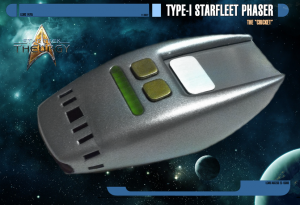
|
| Type-I Phaser |
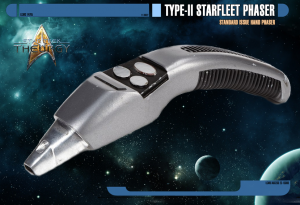
|
| Type-II Phaser |
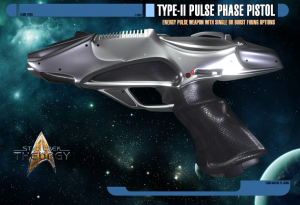
|
| Type-II Pulse Phase Pistol |
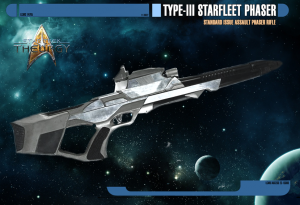
|
| Type-III Phaser Assault Rifle |
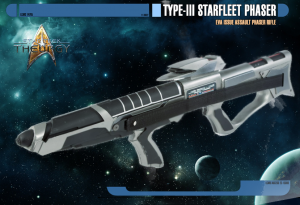
|
| Type-III EVA-issue Phaser Assault Rifle |
Phasers (an acronym for PHASed Energy Rectification) were the most common and standard directed energy weapon in the arsenal of Starfleet and several other powers. Most phasers were classified as particle weapons and fire nadion particle beams. Based on the intensity and field of the beam and a variety of adjustments, a wide variety of effects could be achieved. All Starfleet phasers followed a similar naming convention, with the lowest being handheld and each higher number becoming more powerful and larger in size. After the Type-III, Phasers were too unwieldy to be hand operated and required such power that they were only suitable to be attached to vehicles, vessels, or outposts.
Handheld Phasers
Utilized primarily in defensive situations, Handheld phasers had several applications, from use as a weapon to use as a cutting tool, explosive device, or energy source. Storing considerable energy, most phasers were distinguished by their size and firing capabilities, with all models able to output a focused energy discharge in the form of a beam or steady stream.
Type-I
Colloquially know as the "Cricket", the type-I phaser was the smallest, most basic weapon carried by Starfleet and other Federation personnel. Easily concealable, the type-I was able to be programmed to fire automatically at set intervals. However, due to the lack of its operating capabilities, longevity, and diversity when compared to its larger brethren, the type-I phasers were typically only carried when it would be inappropriate to carry a larger weapon, such as on diplomatic missions. Because of this, the type-I was synonymous with secret missions and seldom seen in active use.
Type-II
The type-II was the standard weapon used aboard all Starfleet vessels and bases, as it offered a very favorable compromise between size and power. Originally designed to encompass the type-I, the type-II held a pistol-like grip. By the 2360s, the type-II had evolved past that configuration, becoming a sleek, silver-colored device with a handle flowing into the form of a muzzle cowling and emitter. The type-II phaser was a required piece of equipment for most Starfleet away teams, and was the basic sidearm of Starfleet security teams
With two small buttons for beam width and intensity control and a large one to fire the device, the type-II featured a large, illuminated power level readout. The phaser retained the functionality of the previous designs, but increased the power and versatility. Like their predecessors, these units could be adjusted for use as cutting tools or power sources. They could also be set to overload, becoming a powerful explosive device.
In addition to more variable power settings than the Type-I, Type-II Phasers were able to be set for a "narrow" (affecting a single target) or "wide" beam (affecting two or more targets over a certain area). The frequency of the beam could also be adjusted to make it more effective against certain types of shields and/or force fields.
Type-II Pulse Phase Pistol
During the Dominion War, it became apparent that single beam particle weapons were ineffective against groups of Jem’Hadar. As such, Starfleet Security desired the ability to fire multiple short pulses of energy. The Type-III rifle was easily modified with a change of beam emitter, but due to the smaller size, the Type-II was unable to be modified in such a way.
With the need of a small weapon for use in close quarter situations, this handphaser variant Type-II Pulse Phase Pistol was created. Not only to be easily distinguishable between the conventional Type-II and this pulse fire variant, but to also account for an increased need for stability and accuracy, this new weapon took design elements of more traditional handheld weapons, incorporating a pistol-like grip and hard sight points along the top of the device.
Because of the difference in shape and fire pattern, Starfleet Personnel required further training on this weapon in addition to standard phaser profiency. As such, the type-II Pulse Phase Pistol was standardly reserved for Security and Tactical Conn personnel.
Type-III
The largest standard phaser issued to Starfleet personnel, the Type-III (or simply referred to as the phaser rifle) was a two handed weapon capable of greater accuracy and longevity than its type-II counterpart. Even though the type-III had a much greater energy reserve, this only translated to an increase of longer periods of fire rather than any rise in output levels over one-handed phasers. Phaser rifles were not standard landing party equipment aboard Starfleet vessels. Typically, rifles were equipped only when firepower heavier than that of the type-II phaser was required.
Originally a bulky device with the capability of its rear handle to be rotated into a shoulder stock, the type-III was more streamlined and smaller by the 2360s. In the early 2370s, the need for accuracy caused the design aesthetic of the weapon to change once again, this time the rifle returned to having a shoulder stock but also incorporated a rear pistol-like and front under barrel grip, a combined sight and tactical light, and an integrated shoulder sling for ease of carrying.
The outbreak of the dominion war caused a need for weapons to fire in multiple bursts rather than just a single beam of energy. Starfleet Security created two new weapons for this purpose - the Type II Pulse Phase Pistol and the Type-III Phaser Compression Rifle. By 2375, the Compression Rifle was removed from service, due to comparable capabilities produced from the standard type-III with a change to its beam emitter. The switch between the angular and smooth beam emitters on the type-III rifles allowed the weapons to fire both single beam and pulses of energy at will by the operator.
After the completion of the dominion war, in the late 2370s, Starfleet Security updated the sights of the type-III to a red holographic style allowing for great accuracy and target acquisition. The integrated flashlight was unaffected.
Type-III EVA Variant
During the 2370s, Starfleet produced an additional variant of the type-III specifically designed for EVA missions. This rifle had unique features including, two pistol-like grips for ease of handling, no trigger guard to allow for use by personnel wearing EVA Suits, and magnetic areas allowing the rifle to be attached to a ship's hull.
This variant was later removed from service by Starfleet; however, due to its popularity among officers, there were still many units available in the field. Before the acquisition of the Accipiter rifles Ryuan Sel, the Mistress-of-Arms of the USS Theurgy was known to prefer this weapon.
Phaser Rifle Evolution
Settings
All handheld Phasers used a common scale to denote the power output of the weapon, however, not all phasers could achieve the highest settings. Type-I Phasers were only able to reach settings 1-8, whereas type-II and type-III are able to make use of all sixteen.
| Power Setting | Effect | Notes |
| 1 | Light Stun |
|
| 2 | Medium Stun |
|
| 3 | Heavy Stun |
|
| 4 | Low Thermal |
|
| 5 | High Thermal |
|
| 6 | Low Disruption |
|
| 7 | Moderate Disruption |
|
| 8 | Medium Disruption |
|
| 9 | High Disruption |
|
| 10 | Extreme Disruption |
|
| 11 | Slight Explosive |
|
| 12 | Low Explosive |
|
| 13 | Moderate Explosive |
|
| 14 | Medium Explosive |
|
| 15 | High Explosive |
|
| 16 | Extreme Explosive |
|
Vessel-mounted Energy Weaponry
Directed energy weapons projected bolts or beams of focused energy or energized particles at a target. These weapons were commonplace, with most cultures having some form or another of directed energy weapon as the typical armament of their spacecraft, and they drew upon the abundant energy that starships generated. Energy weapons were composed of a type and a delivery method. Federation starships rarely used any other kind of directed energy weaponry than phasers. The delivery method of a phaser described how the emitters were arranged, and how the weapon was set-up to fire.
Cannons were close range, rapid-firing weapons that projected pulses or bolts of energy rather than consistent beams. These were inaccurate at longer ranges, but the volley of quick pulses could be devastating. Banks were a collection of emitters used early on by Starfleet, designed to fire in unison. They produced a focused beam of energy that could inflict considerable damage. Arrays were a more advanced technology, with long strips of linked emitters that shared a power feed, allowing the ship to fire from any point along the strip. This allowed the ship to fire in multiple directions at once, or to adjust and fire on moving targets repeatedly in quick succession.
Originally, starships used phaser banks. Each bank contained one or more phaser emitters from which the beam energy was released. These systems shared common power sources and targeting systems. In the 2270s, phaser power systems of Federation starships were redesigned to channel power directly from the warp core, thereby increasing the power output of phaser banks.
By the 24th century, the number of emitters in each bank had been increased to the point where they were laid out in long strips called phaser arrays. The arrays aboard a Galaxy-class starship could channel vast energy in a short time frame, capable of cutting through a mile of solid granite in seconds. Starship-mounted phasers were normally set to fire steady streams of phaser energies that would travel along the emitter strip and converge at the best position for targeting. Following the Battle of Wolf-359, Starfleet Engineers were also able to reconfigure the emitters in a different layout that allowed the phaser bank to rapid-fire as phaser cannons.
In addition to the powerful settings, the ship's phasers also had a stun setting that could be used to render lifeforms unconscious when fired at a planetary surface from orbit. It was also possible to configure starship phasers to also fire energy beams for power transfer.
There were many different type-of phasers mounted to starships. As new phaser technology became available, it was placed onto the ships being built at the time. Below are a few examples of phaser types mounted to various ship at the time of their initial construction.
Type-IV Phaser Bank
The smallest phaser bank currently deployed in the Federation, the Type-IV was markedly superior to the Type-III phaser rifle, providing more power, range, accuracy and adaptability. As such, it had been the workhorse of Starfleet's auxiliary craft fleet for decades, as well as being mounted on a number of ground based vehicles. Only by 2381 is it being replaced by the Type-V array, a weapon of comparable simplicity but greater ability. It was not a very strong offensive measure but was capable of warding a small craft from many natural threats, such as asteroids and debris, and similar sized craft. Type-6 Shuttlecraft were known to operate with Type-IV Phasers.
Type-V Phaser Bank
A phaser bank generally found on small but high-powered Starfleet shuttlecraft, the Type-V was generally considered to be the next feasible replacement for the Type-IV array found on several thousand shuttles throughout the Federation. While not as powerful as the Type-VI or Type-VII, what it lacked in strength and longevity was more than made up for in its simplicity. Indeed, it rivalled even the modern Type-IV variant commonly found on shuttlecraft for ease of construction, maintenance and repair.
Type-VI Phaser Bank
The second largest bank used on small craft such as runabouts, the Type-VI phaser bank was undeniably more powerful than its more dimunitive counterparts, with faster recharge rates, ranges and, of course, offensive capabilities, but lacked several of the advantageous maintenance and power factors found in its Type-VII fellow. Most remarkably, the Type-VI's increase in power over its smaller counterparts was less than the equivalent difference between it and the Type-VII, a characteristic explained by the (then) advanced techniques used in its construction and new methods of energy dissipation.
The Type-VI was not as commonly found as any of its counterparts, primarily due to the detailed work required in constructing it and the real but admittedly barely significant advantage in tactical situations it provided over the Type-V. It had, however, been found to be a suitable armament for some shuttlecraft, its intricate composition easily adaptable to some shuttles' requirements.
Type-VII Phaser Array
The largest emitter used on small craft such as runabouts and light escorts, the Type-VII phaser array was considerably more powerful than its more dimunitive counterparts, with faster recharge rates, ranges and, of course, offensive capabilities.
Recent advances in technology had allowed Starfleet to decrease the overall size of the Type-VII, thereby allowing it to be employed on vessels previously considered to be much too small to cope with the necessary machinery. As such, the Type-VII was markedly superior to the Type-VI phaser array but, due to practical issues, fell a bit short of the standard Type-VIII arrays being deployed on starships as of 2381.
Type-VIII Phaser Array
The Type-VIII was the phaser armament of choice for most of Starfleet's small-to medium-sized ships. While varying degrees of power and capabilities could be found from class to class - even from ship to ship - the general Type-VIII operating principles remained the same and any deviations in any regard were usually negligible. This phaser type-provided excellent offensive and defensive capabilities for many ship classes that, due to their size, required significant quantities of internal volume for other operations which would otherwise be consumed by larger phaser weaponry.
Originally these weapons were installed in phaser banks aboard ships like the Excelsior-class and Constellation-class. Ships equipped with them as of 2381 were set in the standard array package. The only fighters that held dedicated Type-VIII phaser emitters were the AC-477 Mk I Valravn fighters, and those emitters were prototype-technology as of 2381, mounted on only twenty constructed fighters. On these fighters, the warp drive plasma conduit ran through the primary phaser coupling to double the power of the beams. It is as of yet unknown how the emitters would last in a prolonged engagement.
Type-IX Phaser Array
This was the armament of choice for many of Starfleet's larger vessels and some of its medium-sized but patrol/combat-oriented craft. While bulkier and more complicated than its Type-VIII counterpart, the Type-IX provided excellent firepower with an impressive rate of fire that could only be bettered by Type-X, Type-XII or Type-U weapons.
Recent advances in weapons technology had allowed Starfleet to reduce the operating size for the Type-IX's components, allowing for this array to be employed as the new phaser weaponry of even refitted 23rd century starships.
Type-X Phaser Array
Until the development of the Type-XII, the Type-X was the heaviest weapon in use aboard Federation vessels, comprising the main armament of the Galaxy class starship. The Type-X had since seen its incorporation into other ship classes, providing significant firepower to some of Starfleet's largest vessels. Galaxy and Intrepid-class vessels were originally fitted with Type-X Phasers.
Type-XI Phaser Array
Type-XI phaser was used normally for planetary defense. The emitters were designed to minimize atmospheric blooming of the beam. The phaser emitters in the carriages, embedded into the habitat ring of Deep Space 9, were of this type, modified for use in space.
Type-XII Phaser Array
Previously designated as the 'Type-X+' for security reasons, the Type-XII phaser has been used in dedicated planetary defence arrays and as the main armament of heavy fortified starbases since 2363. It was considered that the Type-XII was unsuitable for use on a starship because the power requirements were too high and the support systems too bulky. However, by 2368 technical improvements had allowed for considerable shrinkage in the size of the equipment, and ship power systems had become capable of supporting the weapon. The main phaser armament of the new Sovereign-class starship therefore comprised Type-XII phaser arrays, as did the armament of the Prometheus-class. These are the most powerful phaser beam emitters currently in use by the Federation, the pulse phaser variant not withstanding.
Type-XII Pulse Phaser Array
This was the kind of phaser arrays that the USS Theurgy had installed, where there were two firing options available. Either beam emission or phaser pulse, depending on the situation. See Type-U below for more info on the pulse phaser kind of setting.
Type-U Pulse Phaser Cannon
A relatively new development in phaser technology, the Type-U pulse phaser was the most combat-focused development of the phaser to date. It combined large, nearly flawless emitter crystals with rapid-discharge EPS banks and high-speed beam focusing coils. The system allowed the charge to be stored in the coils for a few nanoseconds, then released it as a layered pulse. Due to its nature, shields and armour had a harder time dispersing the pulse, resulting in more damage to the target. Pulse phasers were first deployed on the USS Defiant, where they managed to cause significant damage to Jem'Hadar fighters in a short space of time.
Type-U+ Pulse Phaser Cannon
This weapon worked on the same principles as the Type-U but at a much smaller scale as well as 40 % of the yield. It was an armament commonly found on the Federation's fleet of fighters and a number of auxiliary craft. The first iteration of the U+ could be seen on either side of the AC-307 Mk II Valkyrie fighter, but a second version was made to be wing-mounted on the AC-409 Mk III Valkyrie. It was the same technology in both versions of the U+ cannons, only on the Mk III, the entire weapon system was mounted on the wings instead of being inside the fuselage of the fighter (as it is in the Mk II). Furthermore, while the technology was the same, as an upgrade from the Mk II, the warp drive plasma conduit ran through the primary phaser coupling to increase the power of the Mk III’s phaser cannons, giving it 50 % yield compared to the Type-U.
There were pulse or beam firing options available. Bolts had a firing rate of 5 per second. The beam setting had lower yield but longer range.
Type-I Rawley Heavy Pulse Phaser Cannon
Like the AC-409 Mk III Valkyrie's wing-mounted pulse phaser cannons, the first and only iteration of the heavy Rawley cannon was also wing-mounted, and it demanded that the warp drive plasma conduit ran through the primary phaser coupling. Unlike the Type-U+, the Rawley cannon had a tendency to overheat during prolonged engagements, instead made for quick strikes and a mandatory cool-down period between such strikes. The benefit was that its yield was higher than the Mk III's phaser cannons, at the lower firing rate of 3 bolts per second. Their yield was approximately 60 % of the Type-U pulse phaser cannons.
The Rawley cannons did not have a beam firing option available, and they were mounted as standard armament on the AC-347 Knight-class Interceptor. After the refit of the SS Sabine NX-59846, it also had two of these cannons mounted underneath its wings.
Disclaimer Notice
Some info on Vessel-mounted Phasers used with permission of USS Wolff CO - granted Jan 30, 2017


